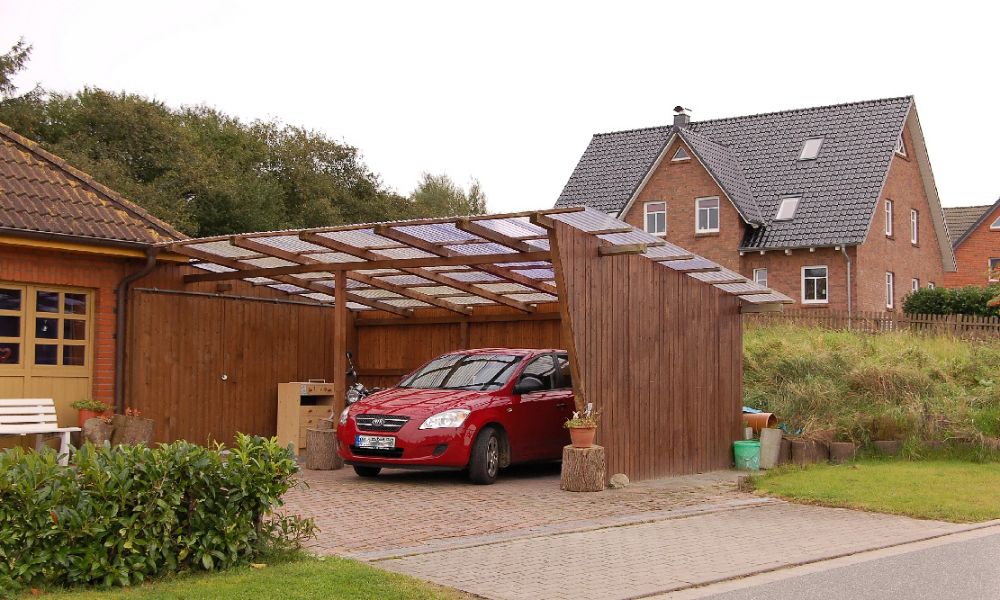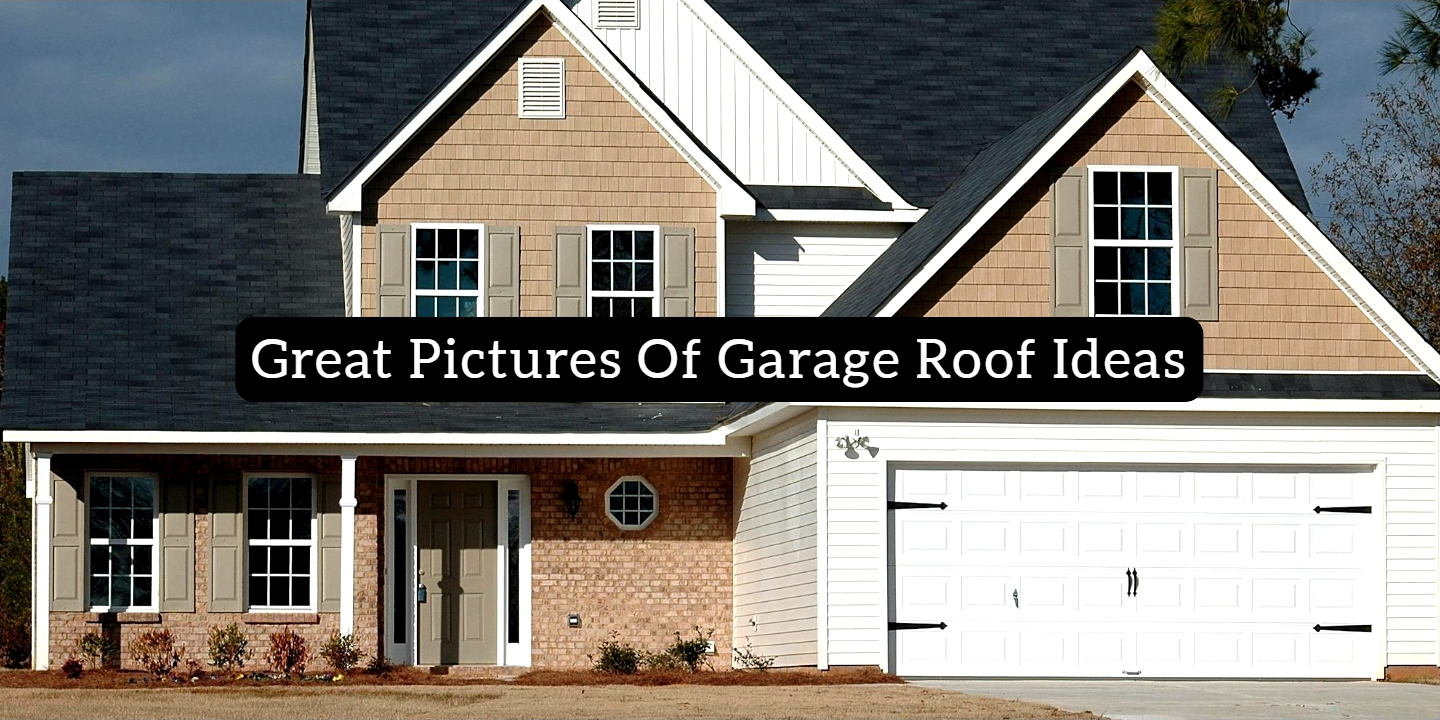Let’s face it, most garages blend into the background, sporting the same old, uninspired roofs. But could you change that? Yes, absolutely!
We’ve rounded up some great pictures of garage roof ideas you could try. Our list isn’t just about aesthetics (although, prepare to be wowed); it’s about functionality too.
From classic to rustic styles, and even customized structures, there’s smth for everyone. These will surely leave you yearning for a roof upgrade. Let’s dive in!
Flat Roof
Such styles are notable for garages and extensions. However, “flat” is a bit of a misnomer. They have a slight incline to allow water drainage, typically covered by felt or rubber membranes.
Pros:
- Low-cost: Requires less material compared to pitched roofs.
- Aesthetic: Creates a clean, streamlined look.
- Additional space: Can be used for rooftop gardens or terraces.
Cons:
- Leaks: Requires meticulous installation and maintenance.
- Limited drainage: Requires proper drainage channels or internal systems.
- Hidden issues: Internal ceilings can mask early signs of leaks.
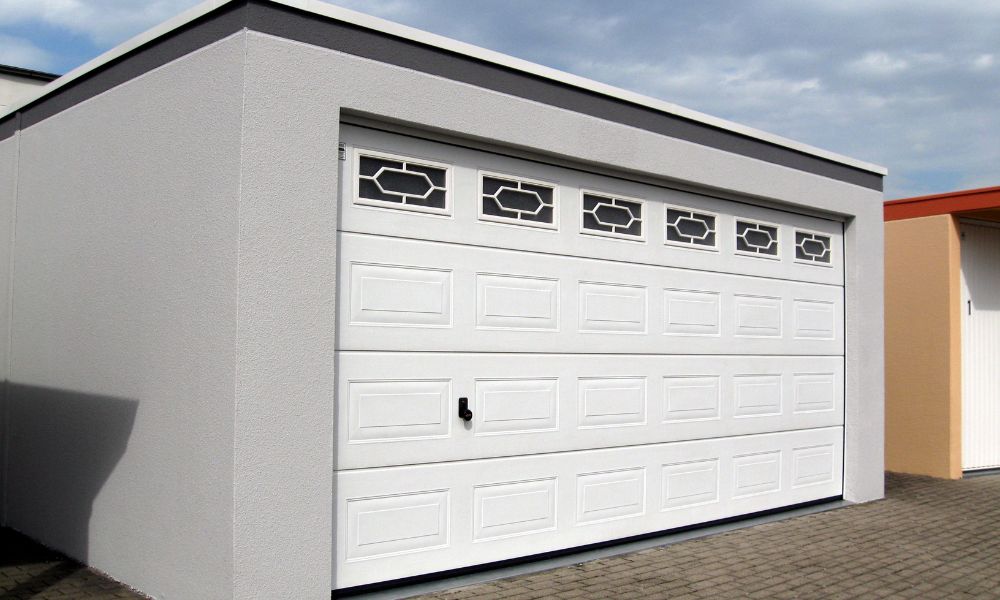
Pent Roof
This one is also known as a lean-to roof. It boasts a single slope, typically higher at one end for improved drainage. They are higher on one end, often leaning against the main building. It leads to better drainage than a flat roof and usually features gutters.
Pros:
- Drainage: The slope encourages water flow, reducing the risk of leaks.
- Low-cost: Requires less material than multi-pitched roofs.
- Simple: Easy to install and maintain.
Cons:
- Limited headroom: Can feel restrictive compared to taller roof styles.
- Limited vent: May require additional ventilation solutions.
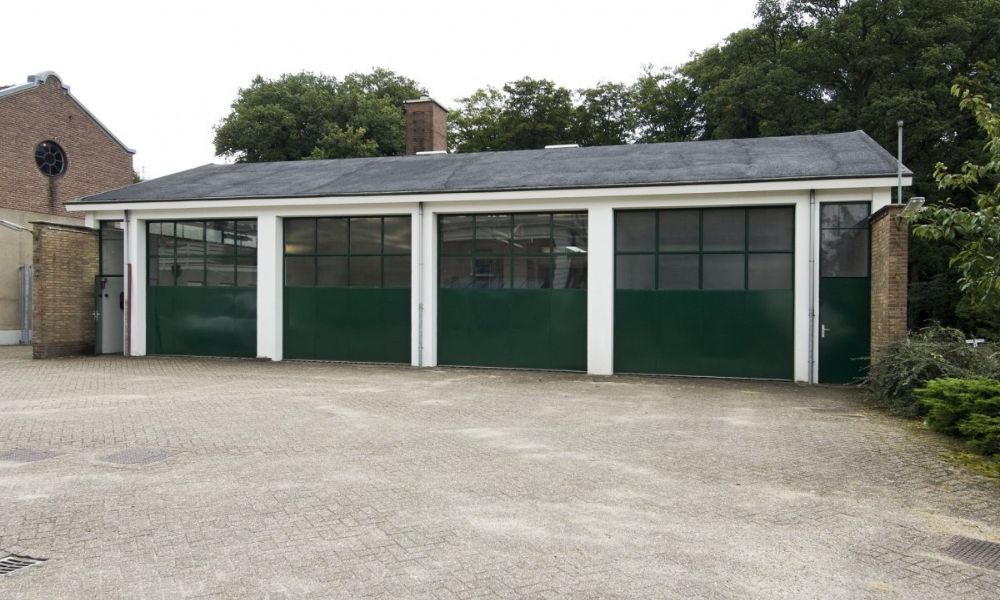
Parapet Roof
This one is essentially a flat roof with raised walls around the edges, creating a barrier for safety and aesthetics. This adds safety and security but it’s not that common for garages. It might be a nice upgrade, though.
Pros:
- Safety: The parapet wall prevents accidental falls from the roof.
- Security: Offers an additional layer of protection against intruders.
- Concealed drainage: Gutters can be hidden within the parapet wall, creating a clean look.
Cons:
- Cost: The added wall construction increases the overall cost.
- Drainage: Improper parapet design can lead to water pooling and potential leaks.
- Maintenance: It may require specialized equipment or access solutions.
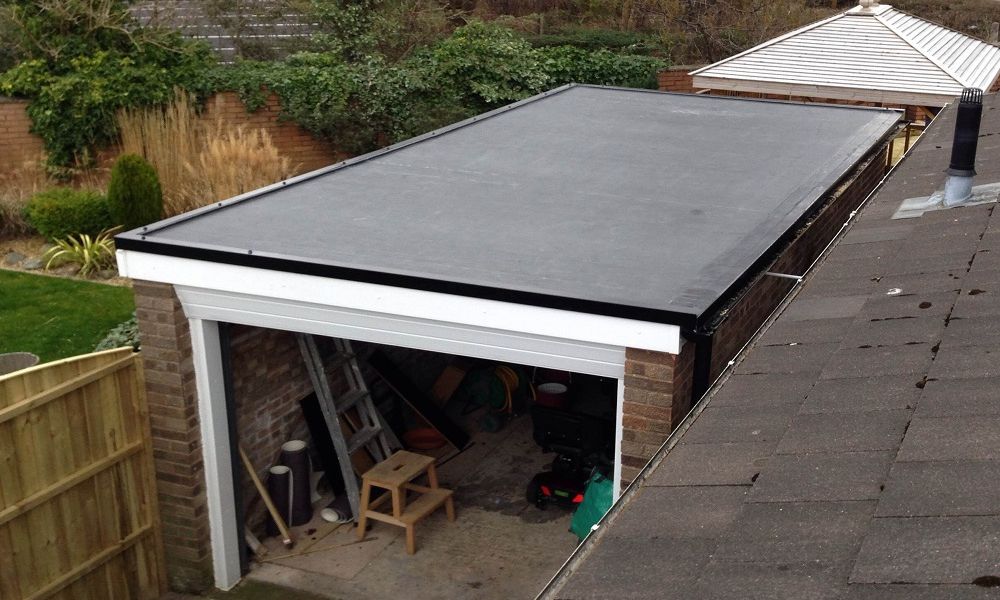
Apex Roof
It’s a classic choice for garages and sheds. It’s triangular-shaped and has equal slopes on both sides meeting at a ridge. You can make it steep or shallow to add a bit more personality, too.
Pros:
- Increased headroom: The peak can provide more usable space compared to flat or pent roofs.
- Drainage: The steep slopes shed water efficiently, minimizing the risk of leaks.
- Style: Can be made with diverse pitches and materials for a customized look.
Cons:
- Complex construction: Requires additional materials and expertise to install.
- Cost: A more complex design translates to a higher overall cost.
- Limited vent: This can trap heat and require additional ventilation solutions.
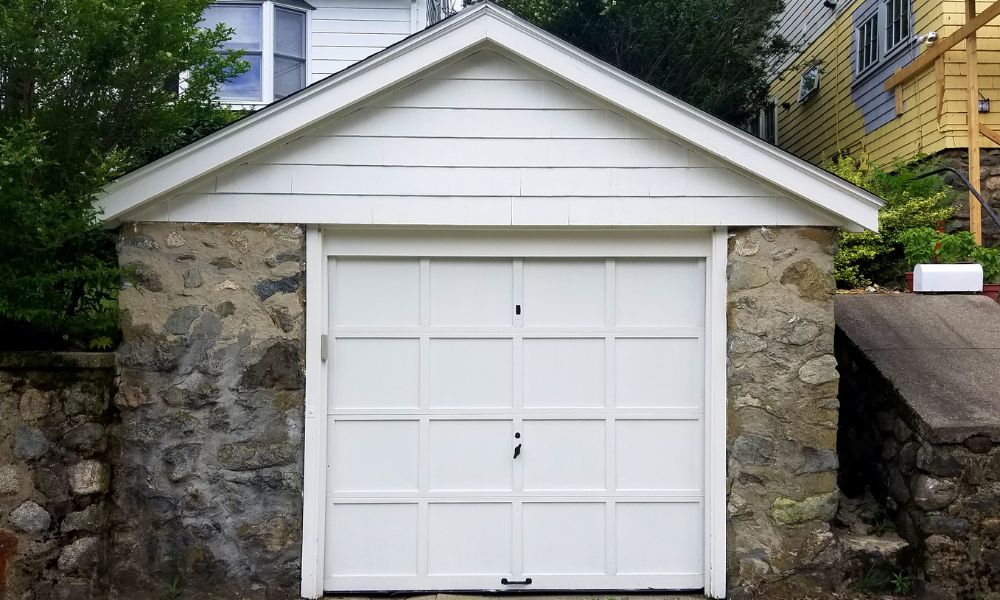
Mono-Pitch Roof
This single-sloped roof is typically found on sheds and outbuildings, with a steep incline on one side. It offers efficient drainage and can be fitted with transparent panels for natural light.
Pros:
- Drainage: The steep slope allows for quick water runoff, minimizing the risk of leaks.
- Increased headroom: The high side can provide more usable space compared to flat roofs.
- Natural light: Can incorporate transparent panels for additional light and a modern look.
Cons:
- Aesthetics: Offers a simpler design compared to other options.
- Wind vulnerability: The exposed slope can be susceptible to strong winds.
- Drainage: May not work for areas with heavy rainfall.
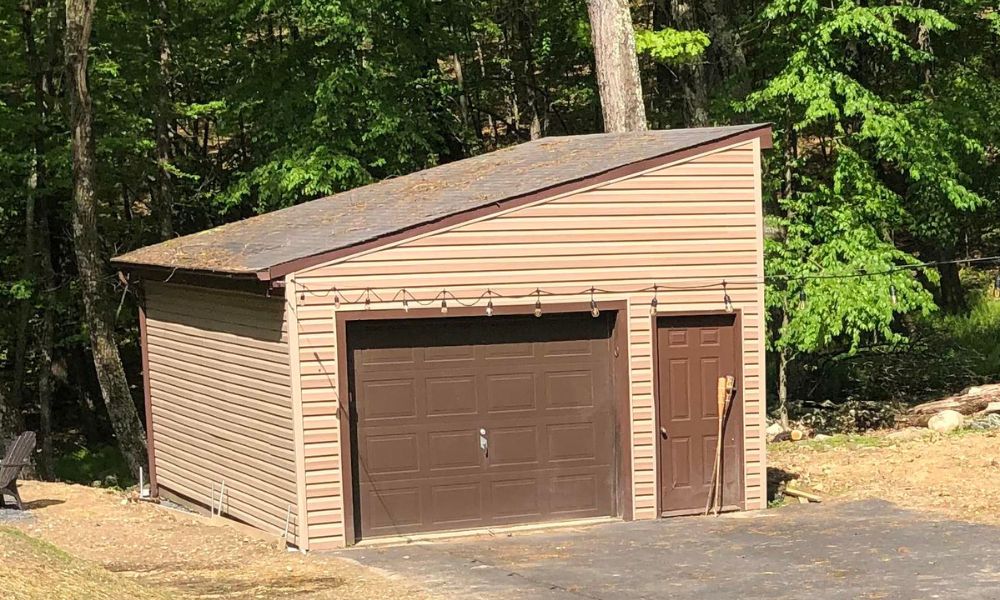
Dual-Pitch Roof
Characterized by two sloping sides meeting at a ridge, it exudes a classic charm. It has a charming countryside cottage vibe to it and looks great if it matches the aesthetic of the main house. Well, it’s practically a traditional house roof, translated onto your garage.
Pros:
- Timeless: Complements diverse architectural styles.
- Increased headroom: Great for areas with lofts or needing ample storage.
- Drainage: Two slopes ensure water flows easily, minimizing leak risk.
Cons:
- Cost: More materials and complex construction add to the price tag.
- Ventilation: May require additional solutions to prevent heat buildup.
- Partial guttering: Typically features guttering only on the rear slope.
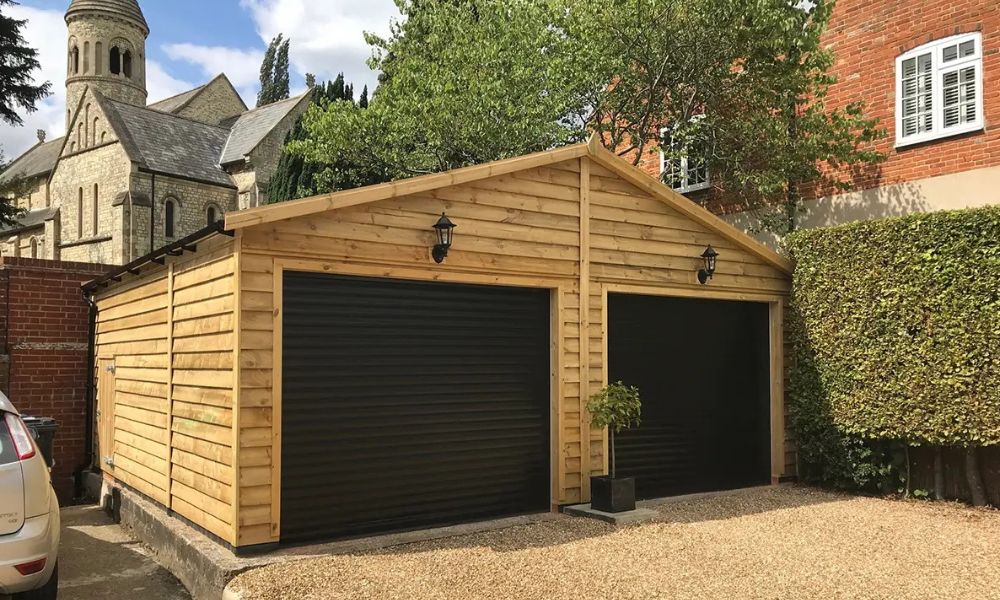
Lean-To Roof
As you may guess, this one attaches to existing structures and prioritizes efficiency over aesthetics. It’s simple and budget-friendly, and you can think of it as a streamlined extension for your garage. Of course, it won’t work if you have a detached garage.
Pros:
- Low-cost: Less material and easier construction make it the most affordable option.
- Drainage: The steep slope promotes quick water runoff, minimizing leaks.
- Space saver: Extends from existing structures, maximizing space utilization.
Cons:
- Wind vulnerability: The exposed slope can be susceptible to strong winds.
- Repair challenges: Leaks can be difficult to repair, often requiring complete roof replacement.
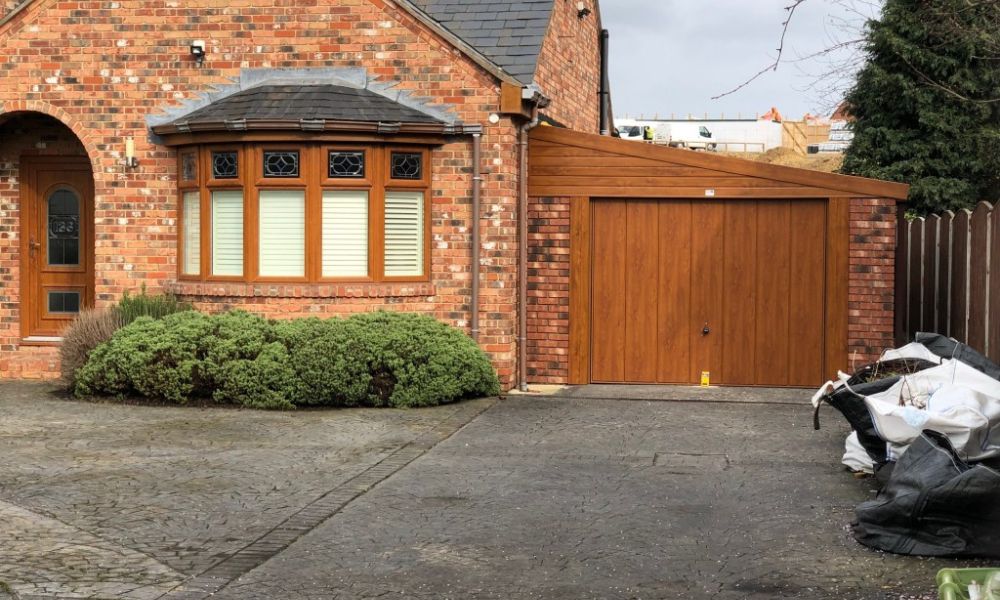
Box Gable Roof
Picture two slopes meeting at a ridge, with boxed extensions on the sides. That’s what it is. Built for harsh weather, it comes with boxed triangular extensions, forming a sturdy and stable structure. It’s a real winter warrior, this one.
Pros:
- Weather resistance: Handles snow and rain effectively, making it a gem for cold climates.
- More headroom: Provides greater usable space compared to flat or Lean-To roofs.
- Versatility: You can cater it to your prefs.
Cons:
- Costly: The complex design translates to higher building costs.
- Ventilation issue: May require additional solutions to prevent heat buildup.
- Snow accumulation: The boxed ends can trap snow, requiring regular clearing in snowy regions.
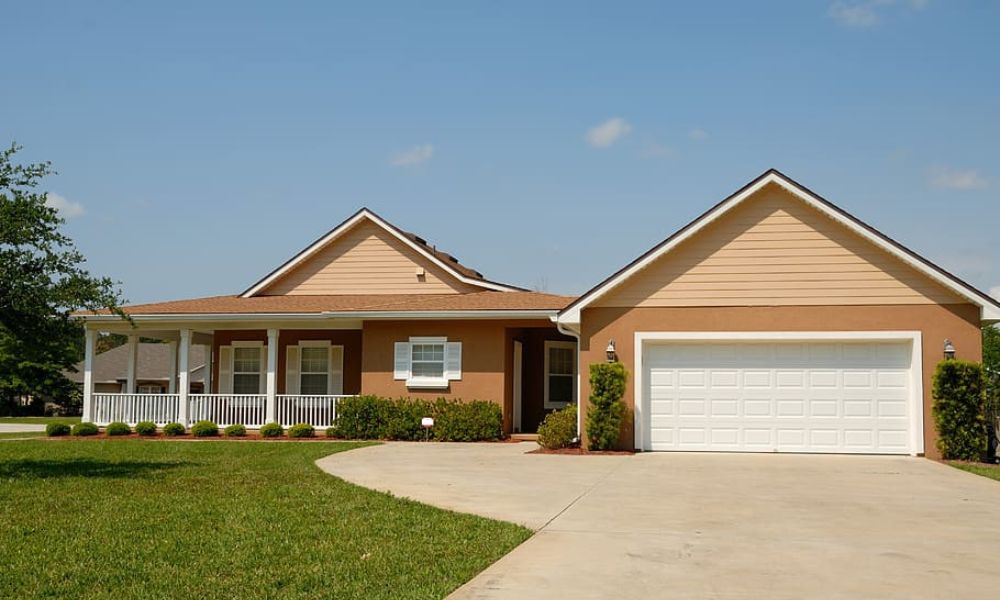
Pyramid Hip Roof
That’s the type you pick if you wanna stand out. But it’s not only about aesthetics. Generally, it’s the shape of a pyramid, each side sloping inwards to a central point. That offers exceptional wind resistance.
Pros:
- Wind resistance: It minimizes wind uplift, nice for windy areas.
- Drainage: Water easily flows off the multiple slopes, reducing leak risk.
- Aesthetics: Creates a striking look for your garage, enhancing curb appeal.
Cons:
- Complex construction: Requires expert installation due to its intricate design, potentially impacting cost.
- Accessibility challenge: The steep slopes can make roof maintenance more difficult.
- Potential snow buildup: Snow can accumulate on the slopes, requiring regular clearing.
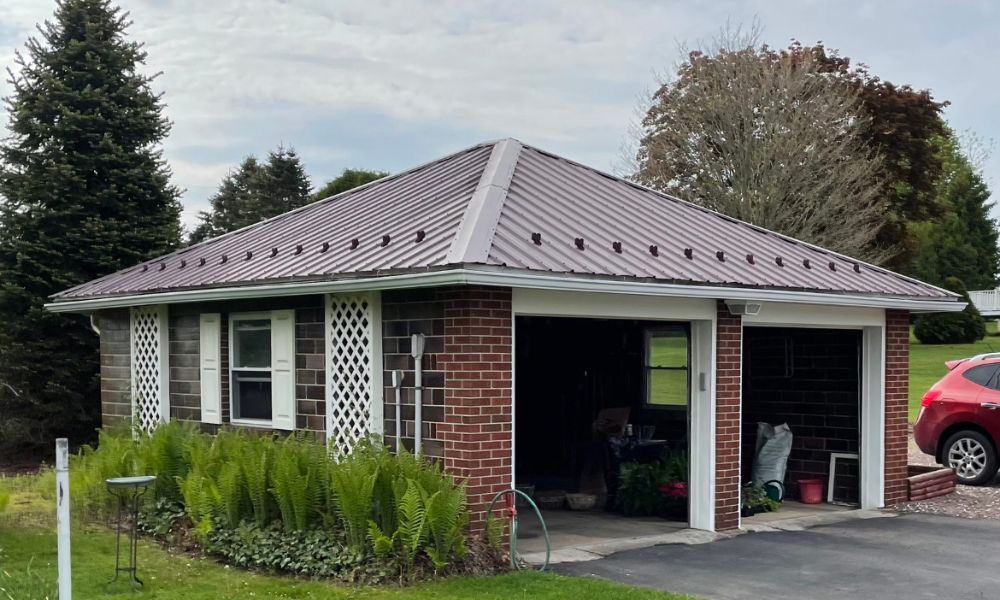
Gambrel Roof
It’s a style of those who enjoy rustic charm as it’s also known as barn roof. Its double slopes create significant headroom, great for adding an extra room above a garage. Of course, you should check if the structure is suitable for it.
Pros:
- Abundant headroom: Ideal for creating lofts, storage areas, or even living quarters.
- Aesthetics: Adds a touch of rustic charm to your property.
- Drainage: Steep slopes ensure efficient water runoff, minimizing leak risk.
Cons:
- Construction cost: The complex framing and roof design significantly impact the budget.
- Increased leak risk: Multiple slopes and valleys require careful construction and maintenance to prevent leaks.
- Ventilation need: May require additional solutions due to the enclosed space.
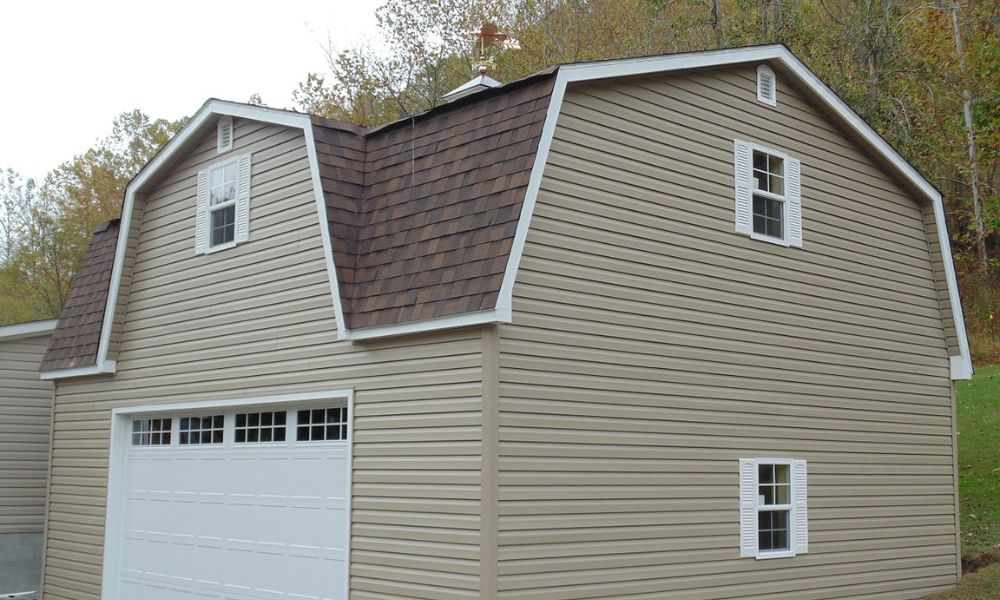
Gable Roof
Chances are, you’ve already seen the iconic A-shaped silhouette like that. It’s a popular choice for standalone garages and for a good reason.
Pros:
- Low-cost: Has lower construction costs.
- Snow shedding: Steeper slopes allow for efficient snow runoff in snowy climates.
- Adaptable: Can be adjusted with diverse pitches and materials to suit your style.
Cons:
- Limited headroom: Offers less usable space compared to other options.
- Potential vent issues: It may require additional ventilation solutions to prevent heat buildup.
- Standard look: Can appear less distinctive.
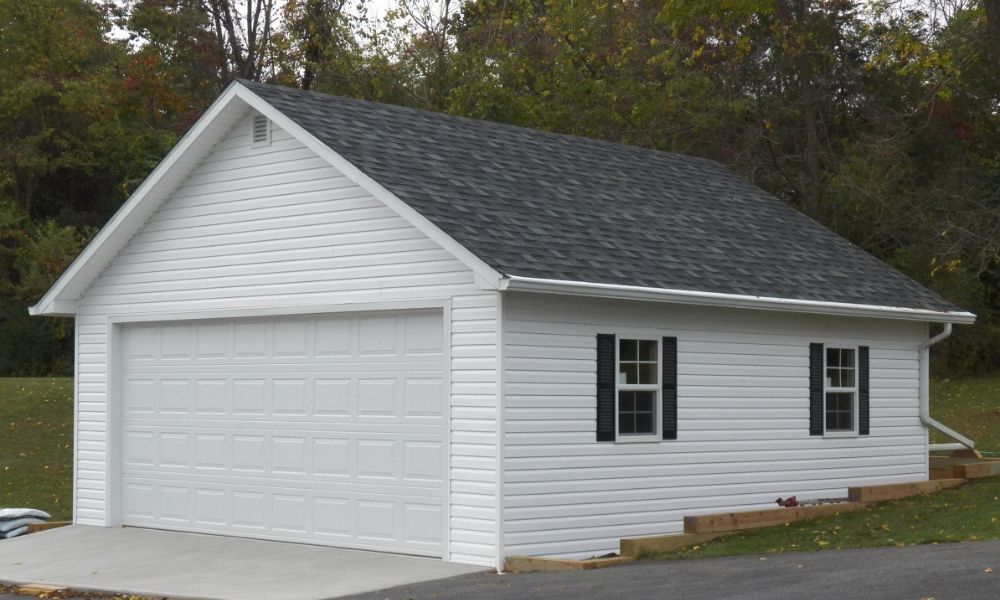
Gable Roof With Shed Roof Addition
This variation on the classic adds a single-sloped shed roof on the side, offering extra space and flexibility. It gets picked as a renovation quite often, as it makes a nice alteration without the need to replace the entire roof.
Pros:
- Increased headroom: Provides more usable space for storage or even a small workshop.
- Aesthetics: Adds a touch of architectural interest to the classic Gable design.
- Cost savings: Can be more affordable than building a full-blown Hip roof.
Cons:
- Increased complexity: Requires additional construction effort compared to a simple Gable.
- Potential drainage issues: Requires careful planning to ensure proper water flow from both roofs.
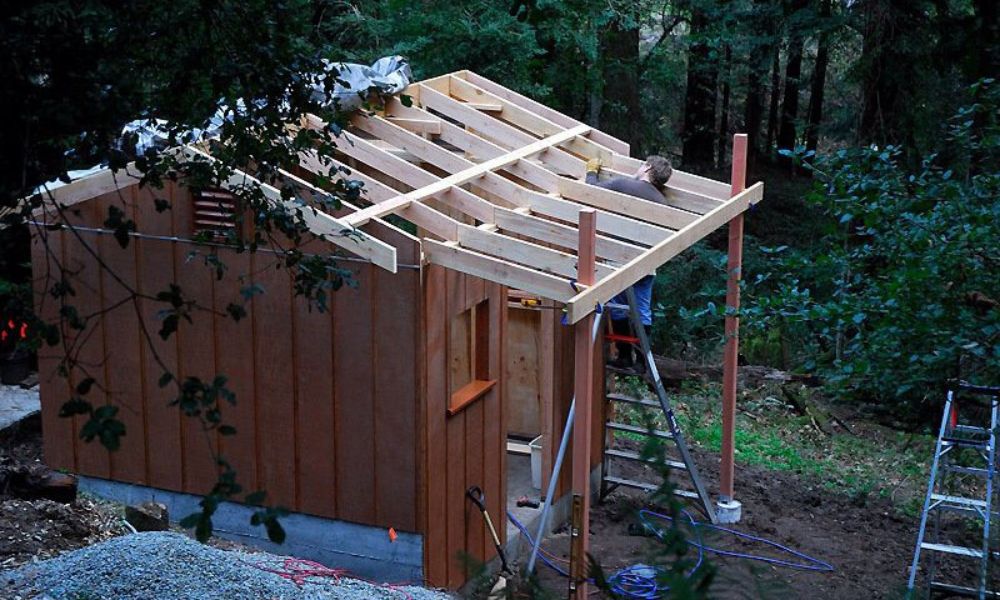
Dutch Gable Roof
This type blends form and function. It offers a compelling combination of aesthetics, functionality, and space. It adds a cool twist to a rather classic style.
Pros:
- Headroom: It creates a spacious attic, ideal for storage or even conversion into living quarters.
- Natural Light: The gable portion allows for strategically placed windows, flooding your garage with natural light.
- Vent: It promotes efficient air circulation, keeping your space fresh and preventing moisture buildup.
- Weather Warrior: The steep slopes of the hip section shed rain and snow effectively, protecting your space from the elements.
Cons:
- Cost Climber: It requires more materials and expertise, translating to a higher price tag.
- Maintenance: The multiple sections and potential for windows necessitate regular upkeep.
- Windy Worries: In areas prone to strong winds, the gable portion might require additional reinforcement for stability.
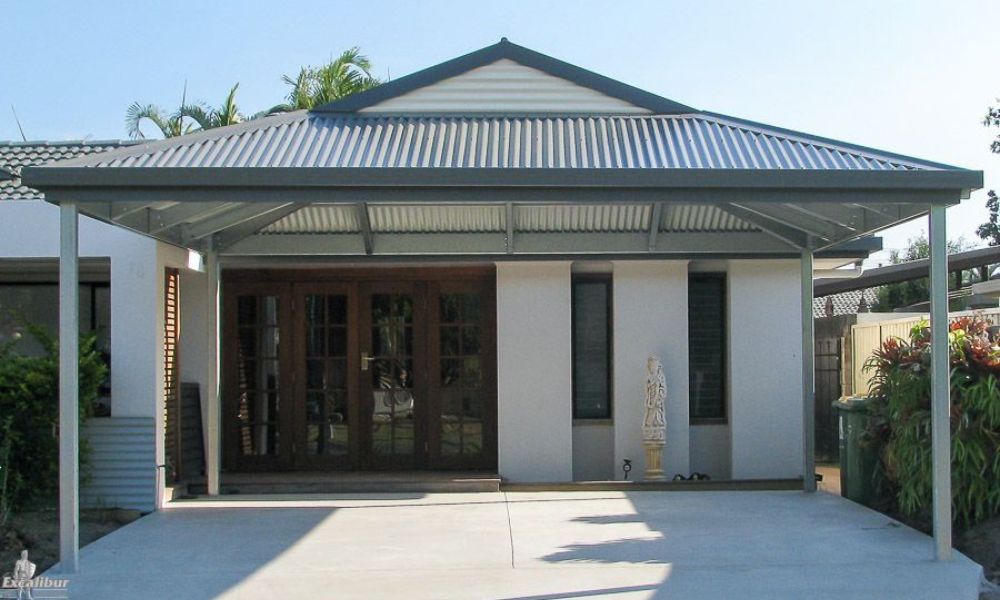
Reverse-Gable Roof
Flipping the script on the classic, this one positions the garage door under the horizontal edge, not the peak. It uses the same type of slope and the only change is the door placement, really. It’s a gem if you want to position a door in an unusual way to face the street.
Pros:
- Accommodates unique layouts: Ideal for situations where space constraints necessitate a door placement shift.
- Aesthetic: Offers a distinct look compared to the standard Gable.
- No functional difference: Performs equally well in terms of drainage and protection.
Cons:
- Limited by space: Requires specific land and garage positioning for optimal functionality.
- May not suit all styles: Can clash with certain architectural aesthetics.
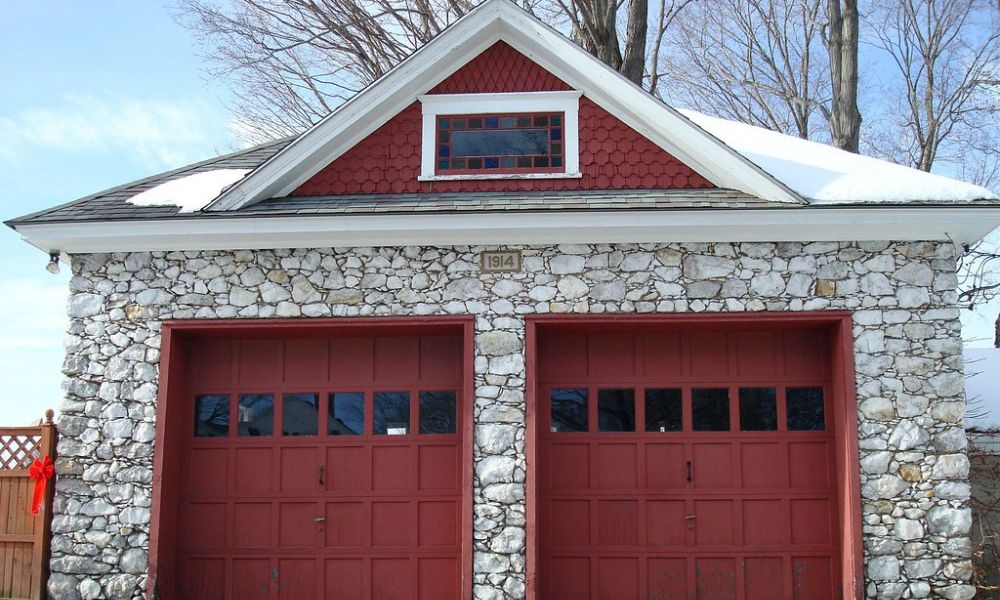
Hip Roof
For ultimate weather protection, this style reigns supreme. It looks like a pyramid with four sloping sides converging at a point. If you live in an area where elements get crazy sometimes, it’s a solid option.
Pros:
- Weather resistance: Provides excellent wind and rain protection due to its design.
- Reduced foundation damage: Generous overhangs minimize water runoff near the foundation.
- Aesthetic: Offers a distinctive and visually appealing look.
Cons:
- Construction cost: More complex design translates to increased building expenses.
- Limited headroom: Offers less usable space in the attic compared to Gable roofs.
- Maintenance: Steep slopes can be more difficult to access for repairs.
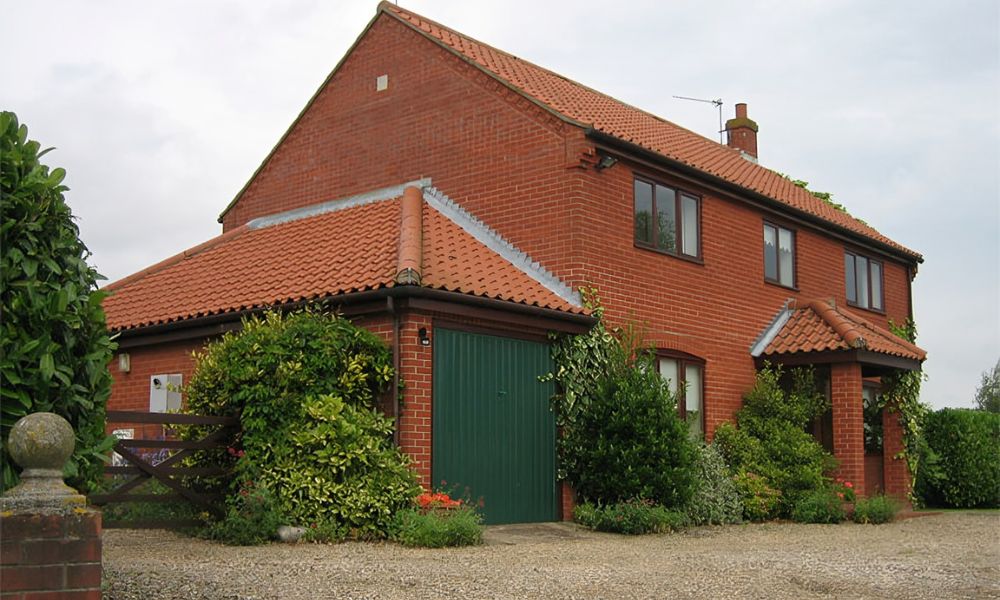
Half Hipped Roof
This option blends the Hip and Gable styles, featuring a shortened hip section on either side. It’s some kind of modern twist and will work nicely if you want to experiment a little.
Pros:
- Aesthetics and function: Offers a modern look with good weather resistance.
- Increased headroom: Allows for more loft space and potential window installation compared to a full Hip roof.
- Low-cost: Less complex look reduces construction costs.
Cons:
- Weather protection: Offers slightly less wind and rain resistance.
- Limited customization: Fewer design options compared to other styles.
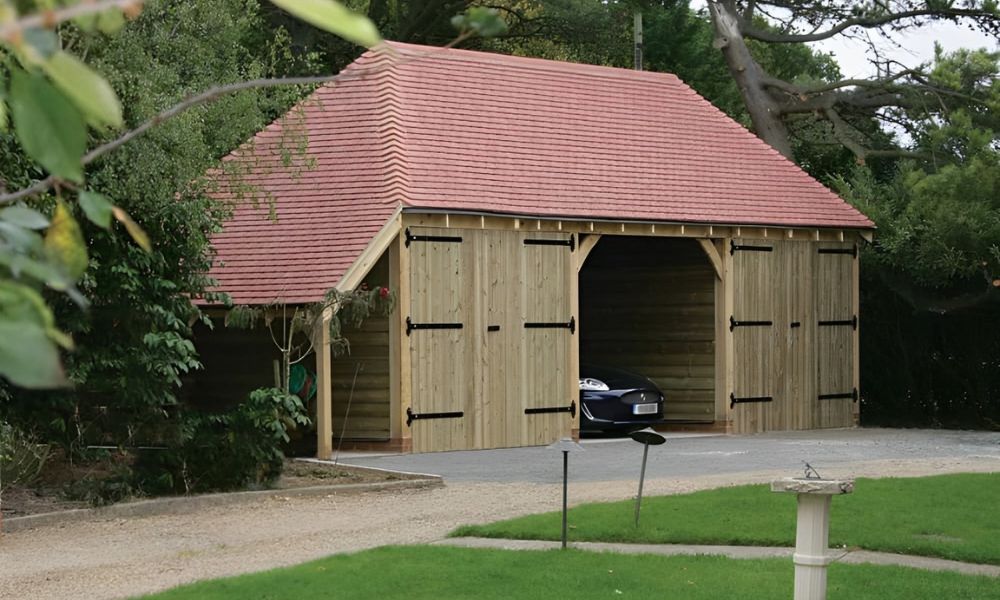
Mansard Roof
Imagine a fusion of gambrel and hip roofs, with four sides and double slopes adorned with dormer windows at the lower angles. That’s what this one is. It blends elegance with practicality and is a true gem for those who want a fully customized garage.
Pros:
- Aesthetics: Adds a touch of sophistication to your property, especially when matching existing architecture.
- Drainage: Double slopes allow for optimal water runoff, minimizing leaks.
- Increased headroom: Lower slopes provide ample space for lofts or storage.
Cons:
- Limited availability: Primarily found on custom-built garages, making it less accessible.
- Higher cost: Complex design translates to increased construction expenses.
- Maintenance: Steep slopes and dormer windows require more attention to upkeep.
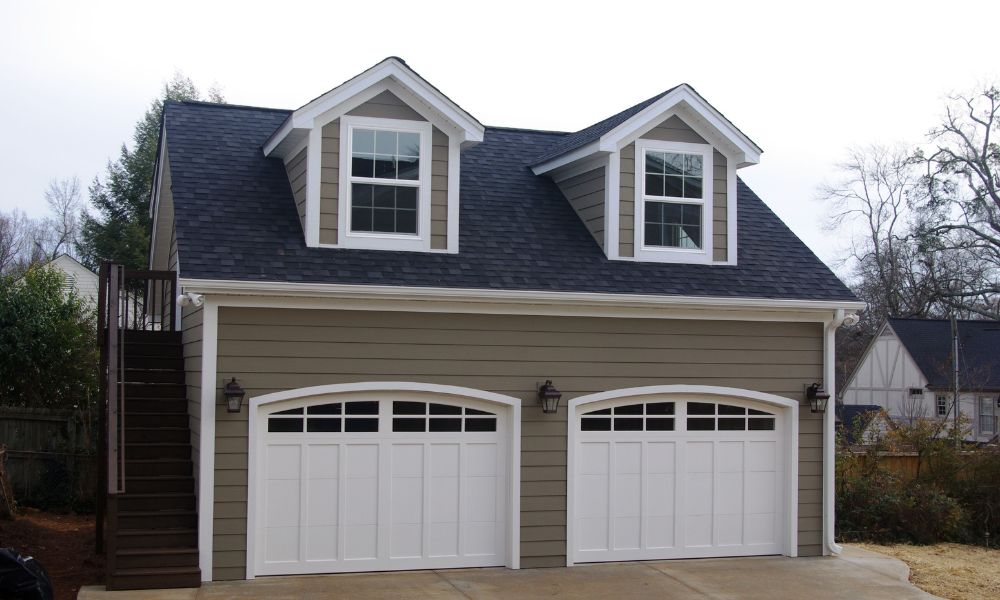
Retractable Roof
Well, that’s surely a pricier option and it’s not for everyone. But just think of how cool it is! It can turn your garage into an open-air patio!
Pros:
- Flexibility: Enjoy the outdoors within your garage or adjust sunlight levels as needed.
- Aesthetics: Creates a unique and modern look, adding value to your property.
- Vent: Allows fresh air to flow freely when open.
Cons:
- Cost: Requires specialized materials and mechanisms, making it a pricier option.
- Maintenance: Regular cleaning and upkeep are crucial for optimal performance.
- Weather protection: Not suitable for harsh weather conditions or heavy snowfall.
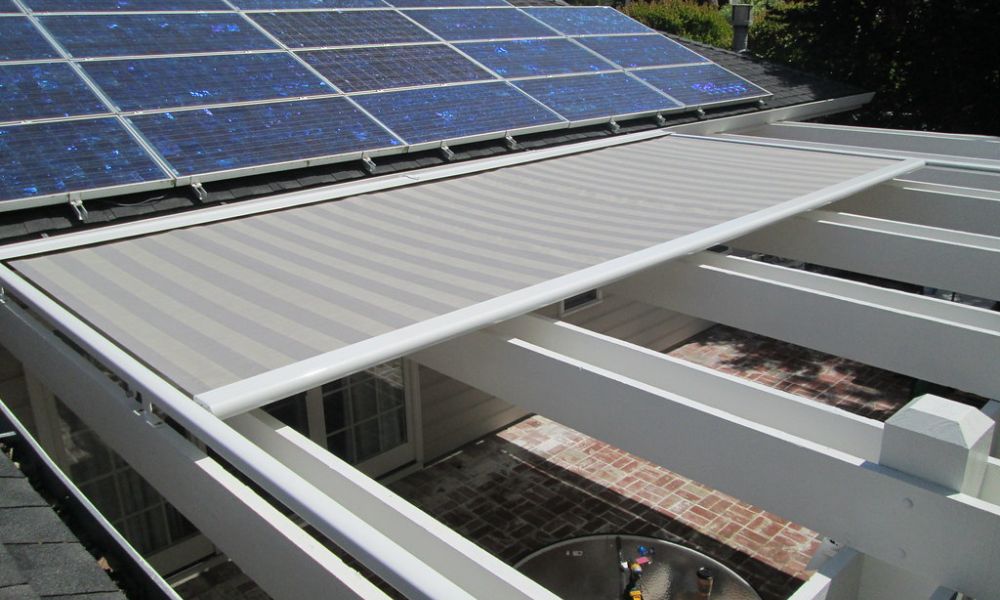
Combination Roof
Don’t settle for one style when you can have two! This type lets you mix and match as you like. It’s a gem for those who want to cater the roof to their needs with both a look and optimized functionality.
Pros:
- Personalized: Unleash your creativity by marrying different roof styles for a unique look.
- Functional: Combine features like a high-pitched section for snow shedding and a flat section for solar panels.
- Visual: Create a captivating focal point that sets your garage apart.
Cons:
- Complexity: Combining styles can increase construction costs and require expert planning.
- Matching challenge: Ensure the chosen styles complement each other and your overall property aesthetic.
- Limited pre-built options: Mostly available on custom-built garages, requiring tailored design and construction.
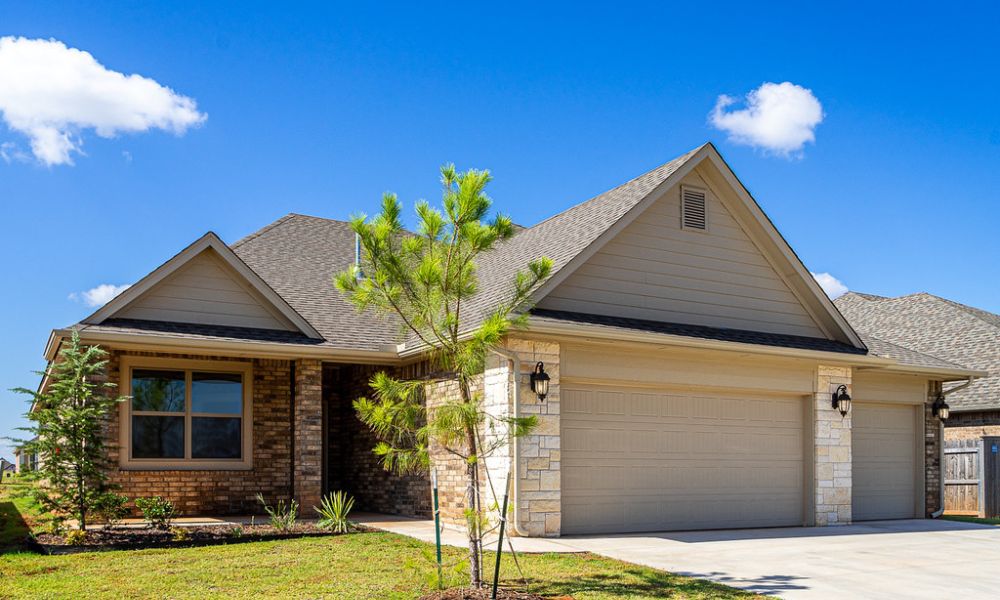
Saltbox Roof
This one lets you fully embrace the asymmetrical charm. It comes with one long, gentle slope and a shorter, steeper one. It was incredibly popular in the 19th century and has recently made a comeback.
Pros:
- Aesthetics: Offers a unique and rustic look reminiscent of historic New England architecture.
- Space efficiency: The longer slope provides ample headroom for storage or loft conversion.
- Drainage: The steep slope on one side facilitates quick water runoff, minimizing leaks.
Cons:
- Limited headroom: The shorter slope offers less usable space compared to other options.
- Potential snow accumulation: The steeper side may require more frequent snow removal in snowy regions.
- Style: May not suit all architectural styles.
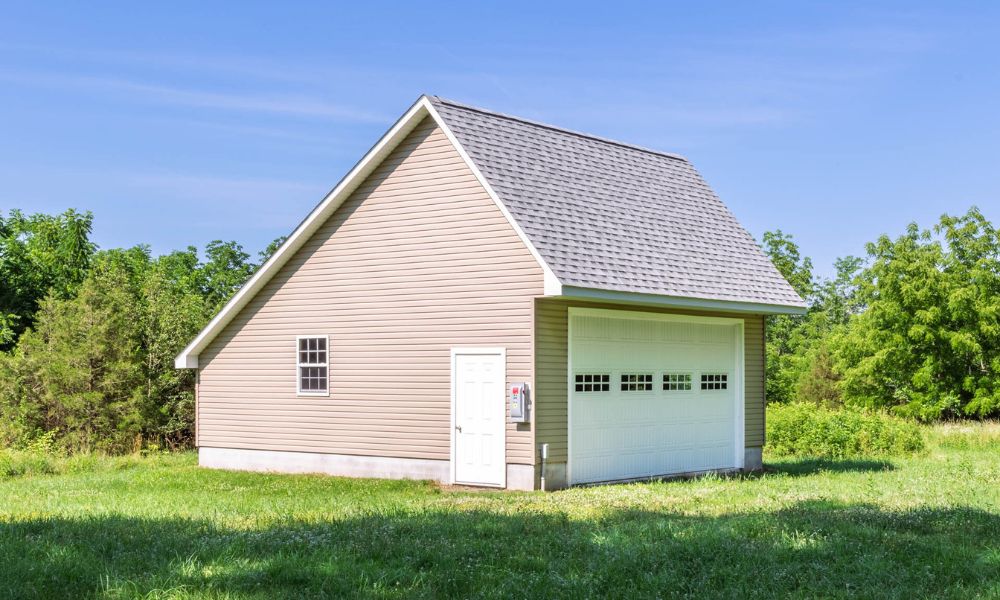
Pergola Roof
If you’re not a fan of standard roofs and would like a sun-dappled haven adjacent to your garage, consider this one. It won’t protect the car from the elements that much (well, maybe rain) and it will be great for those who have an open-air garage.
Pros:
- Aesthetics: Adds a Mediterranean or tropical touch to your property.
- Low-cost: Generally less expensive compared to other roof options.
Cons:
- Limited protection: Provides partial shade and ventilation, not suitable for all weather conditions.
- Maintenance: Requires regular cleaning and upkeep to prevent rot and damage.
- Not for all garages: May not be compatible with all garage styles or designs.
